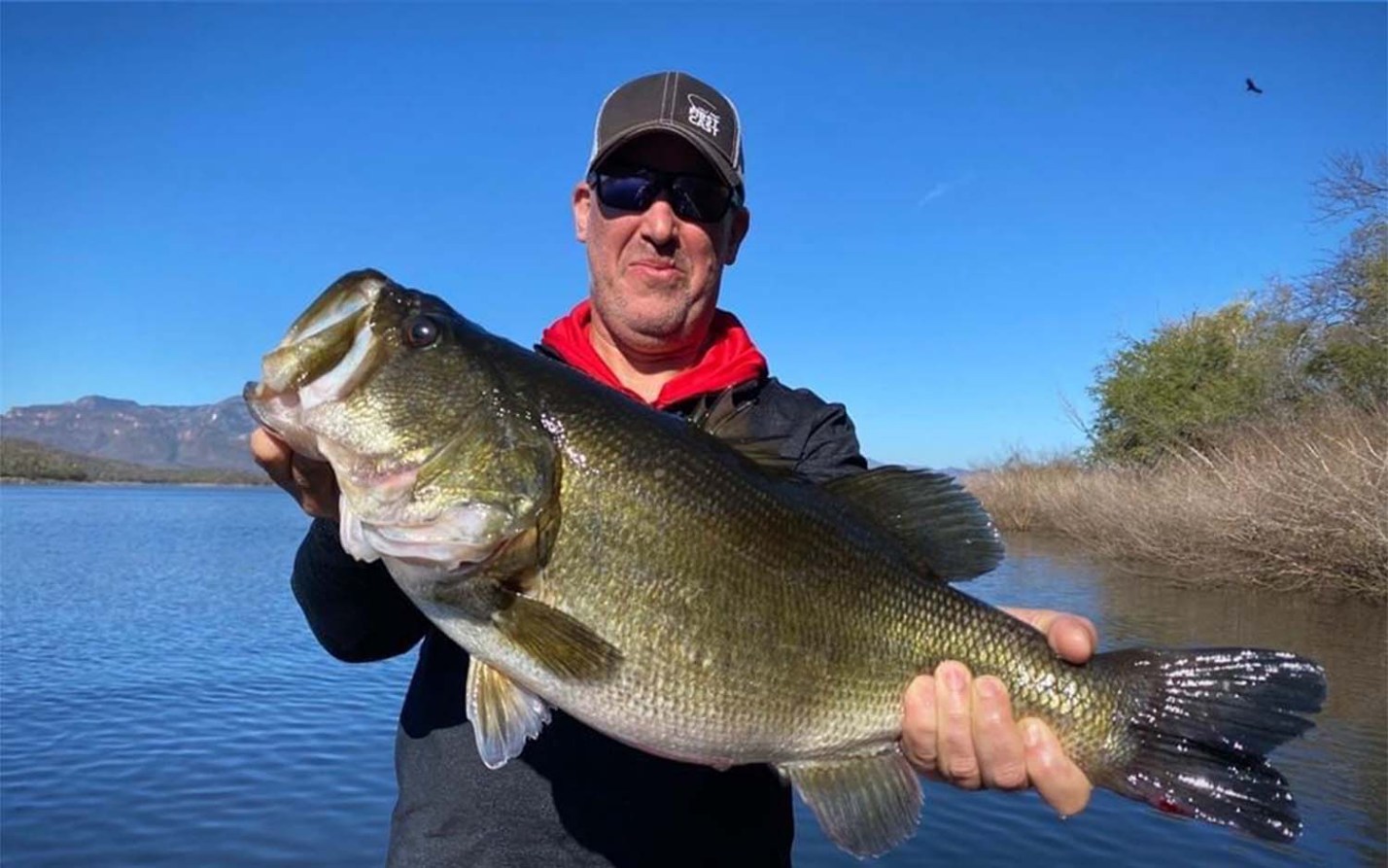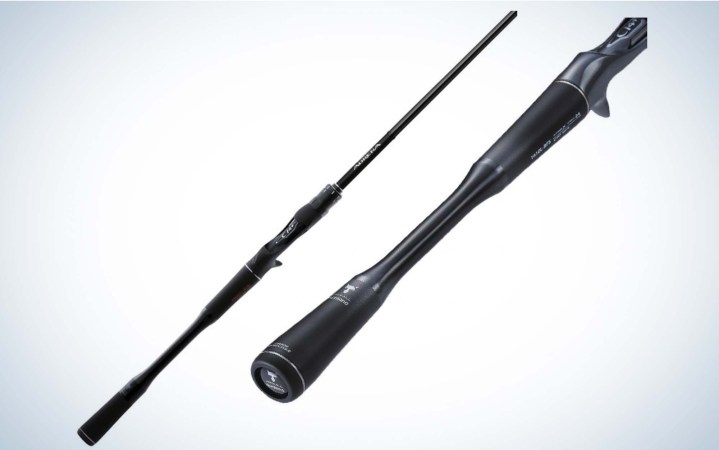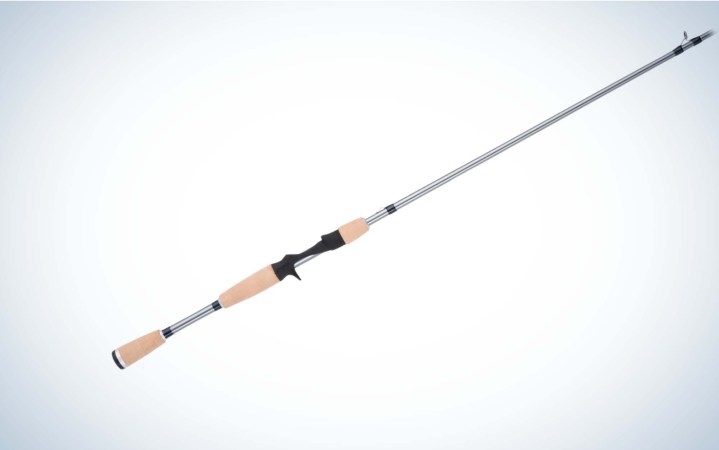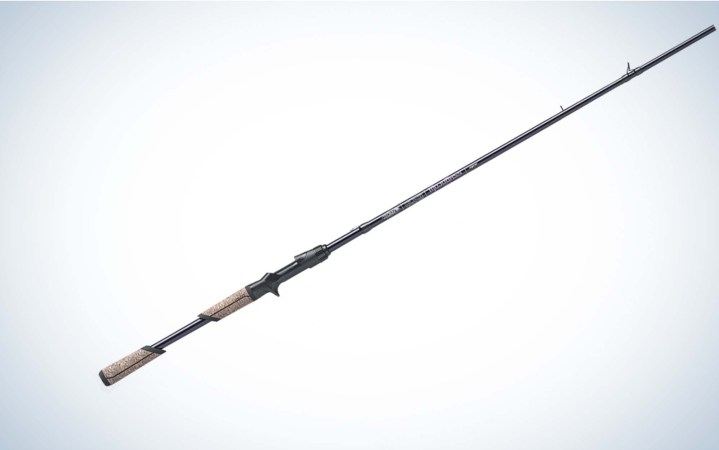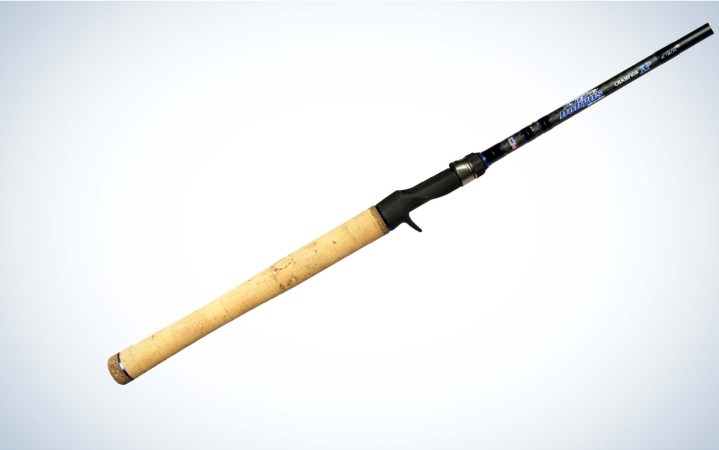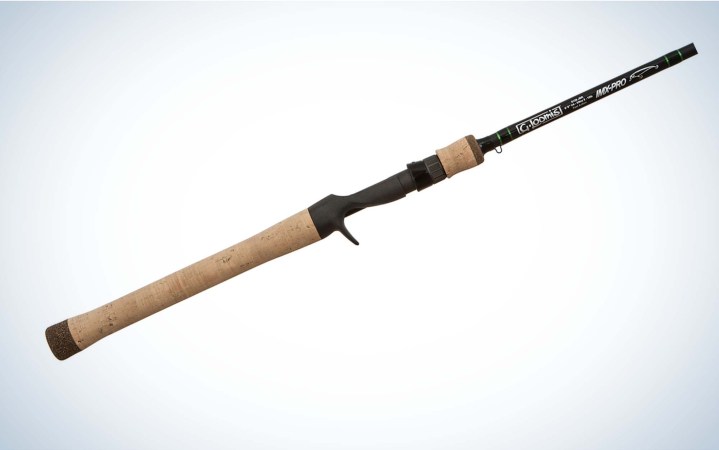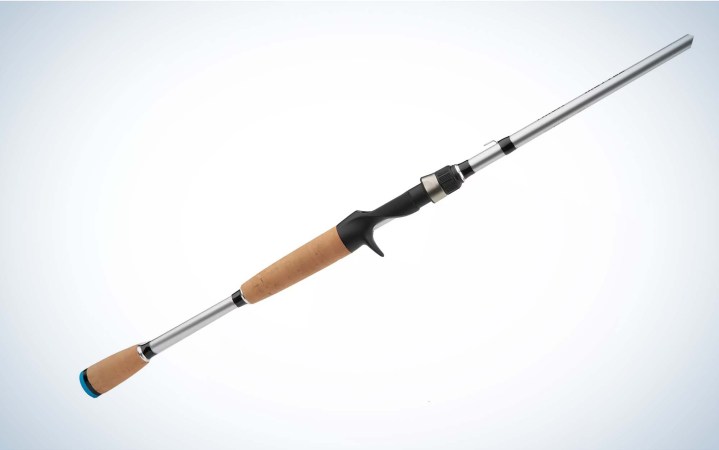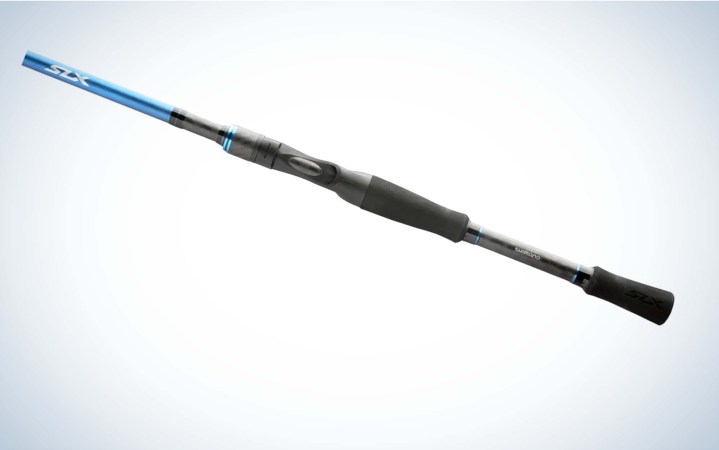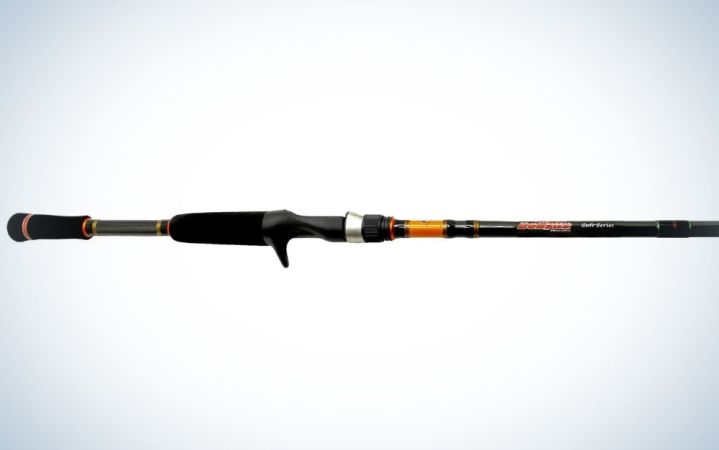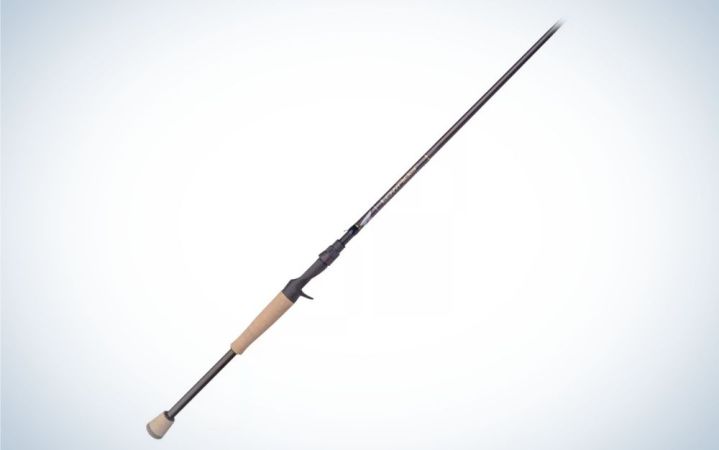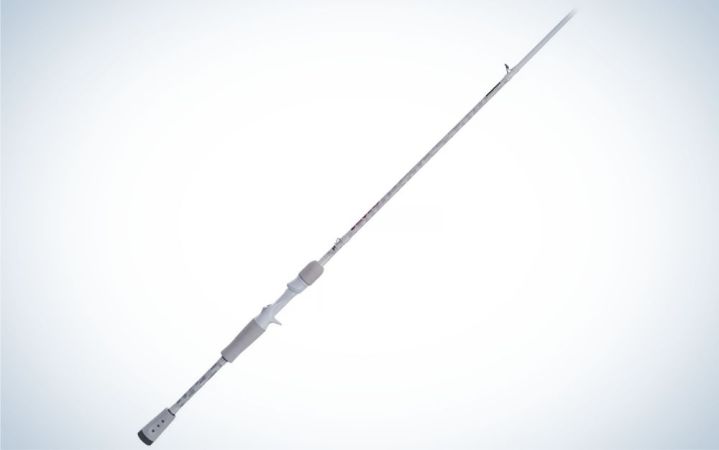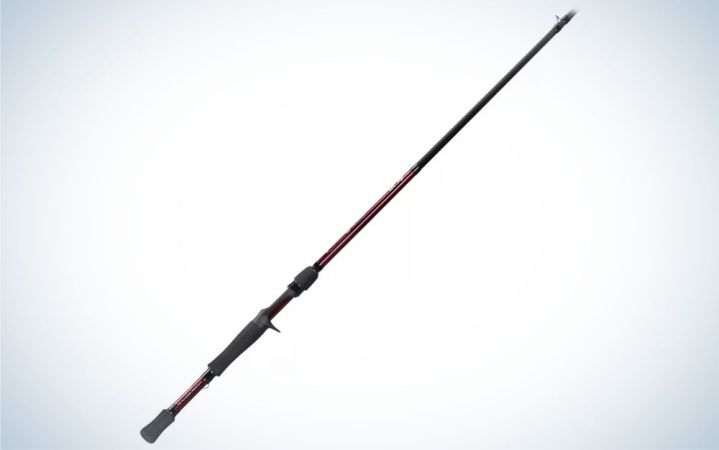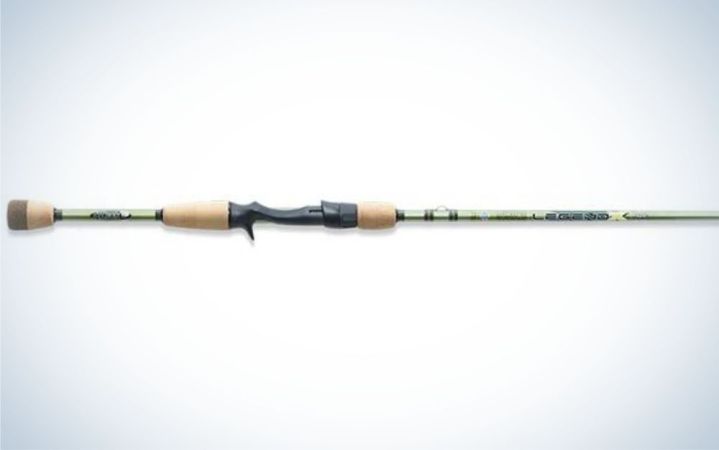We may earn revenue from the products available on this page and participate in affiliate programs. Learn More ›
I collect baitcasting rods like some people collect coins or Beanie Babies or other ephemera. While choosing the best baitcasting rod may be a matter of fishing conditions and personal preference, I know that there are certain ones I go back to time and time again. It’s not necessarily a matter of cost or visual appeal, although sometimes that can make a difference. For me, it’s finding a stick that makes me feel most in tune with the lure that I’m presenting. Often, that’s a matter primarily of blank design, but handle length, handle composition, guide trains and other components often distinguish between something that’s merely passable and a rod that consistently helps me put more fish in the boat.
I’ve been testing a variety of rods this year and here are my picks for the best baitcasting rods for bass.
- Best Premium, All-Around: Shimano Poison Adrena PAD170MHB
- Best for Throwing Light Lures: Fenwick World Class WLDB68M-MFC
- Best for Building a Tournament Arsenal: St. Croix Mojo Bass Trigon JOC71MHF
- Best for Jigs: Dobyns Champion XP DC744C FH
- Best for Jerkbaits: G. Loomis IXM-Pro 812C JBR
- Best Bargain: H2OX Mettle 7 foot MH
- Best Budget Rod for Big Baits: Shimano SLX SLXC75HA
- Best Budget: Dobyns Colt CL734C
- Best for Worms and Jigs: Falcon Lowrider LFC 7-MH
- Best to Put a Beating On: Abu-Garcia Veritas PLX VTCRCW70-6
- Best for Offshore Cranking: Lew’s KVD Composite Cranking Cast Rod 7’4″ Heavy
- Best for Flipping and Punching: St. Croix Legend X 7’11” Heavy Casting Rod
How I Chose the Best Baitcasting Rods for Bass
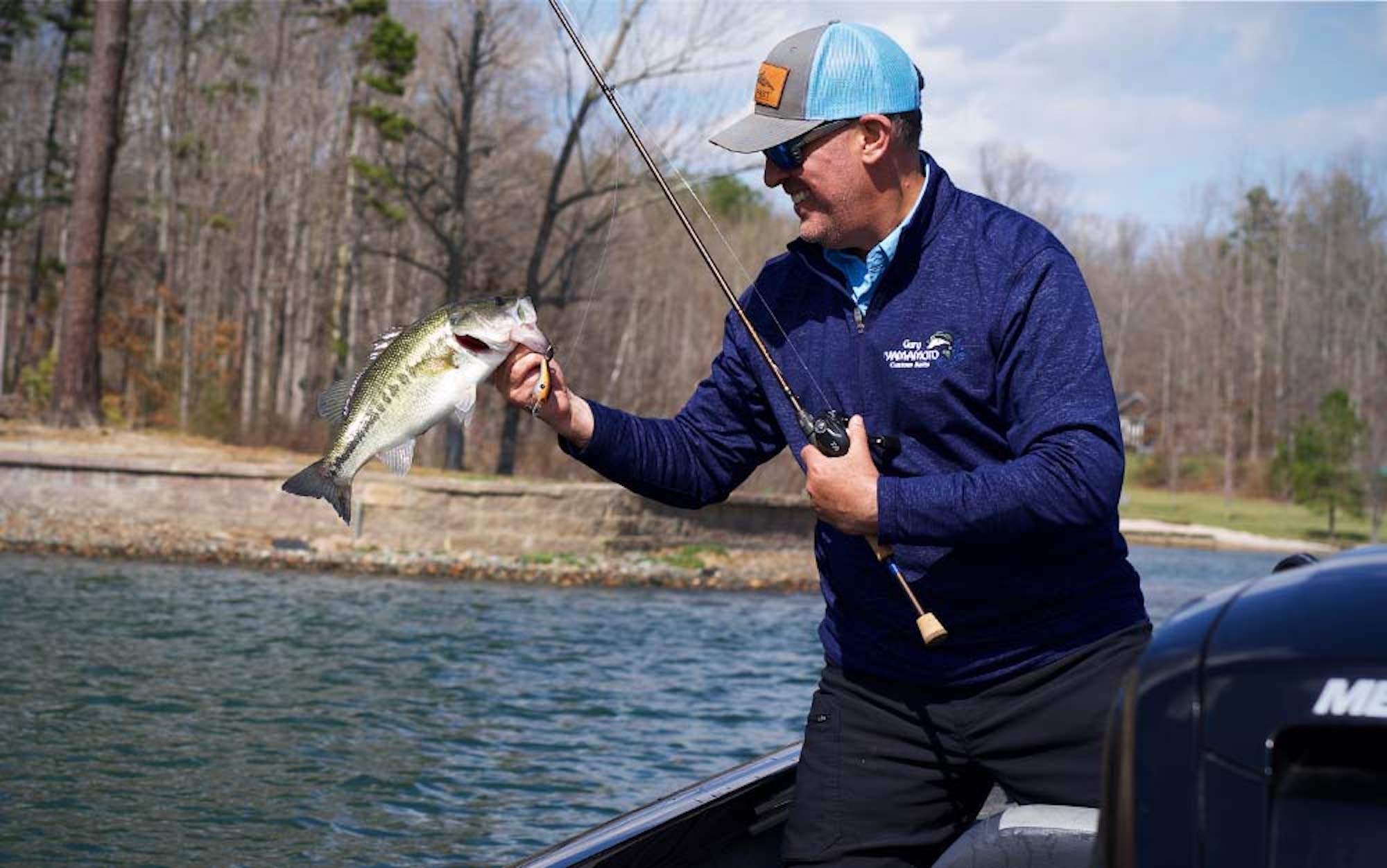
I’ve bass fished from Michigan to Mexico over the past eight months, and I’m anything but a one-lure specialist. In fact, while I don’t like more than seven or eight rods on the deck at a given time, I will cycle through more than a dozen for different purposes over the course of an average day. I fished clear water and dirty, from 6 inches deep down to over 40 feet. I don’t pretend to have the reflexes of a world-class athlete or the fishing skills of an Elite Series pro, so I depend on the best baitcasting rods for bass to help me make the most of every day on the water — and I’m picky.
The Best Baitcasting Rods for Bass: Reviews and Recommendations
Best Premium, All-Around: Shimano Poison Adrena PAD170MHB
Key Features
- 7 feet
- Medium-heavy power, fast action
- Rated for 3/8 to 1 ounce lures
- Carbon Monocoque Handle
Pros
- Extremely sensitive
- Space-age appearance
- Premium components throughout
Cons
- May be above some anglers’ budgets

This isn’t the most expensive rod in Shimano’s lineup — that would be the Poison Ultima series at about three times this hefty price tag — but it’s definitely a high-end tool. It looks like it came straight from a Japanese concept showroom and includes Fuji SiC guides and a Ci4+ proprietary reel seat. What I really liked was the blank, which proved not only light, but ultra-sensitive, and handled lures far below and above the stated weight ratings with grace. I didn’t expect to like the feel of the full carbon monocoque handle, but it was quite comfortable and did not get slippery in wet or otherwise sticky conditions. There are also Poison Adrena models made for crankbaits and BFS applications, but this all-around model covered a lot of bases.
Best for Throwing Light Lures: Fenwick World Class WLDB68M-MFC
Key Features
- 6 feet 8 inches
- Medium power, moderate-fast action
- Rated for ¼ to 5/8-ounce lures
- Multi-material split grip handle
Pros
- Handles lures previously reserved for spinning rods
- Extremely lightweight
- Rebirth of an iconic brand
Cons
- Not inexpensive
I picked this rod up in the late winter and started throwing lures like Shad Raps and small ribbed swimbaits, lures I usually heft on spinning tackle, and I never put it down. Through the subsequent months, I used it for Senkos and Flukes, and I was really convinced of its value when I started using it to throw finesse poppers in the Potomac’s grass beds. Despite being able to throw the lures a mile with accuracy, what truly won me over was the heft it displayed in steering violent fish away from snags and otherwise certain escape. It’s a beast in sheep’s clothing. It also has premium components like titanium guides with thin zirconia inserts, as well as a unique, contoured reel seat. Just make sure you get a light enough reel so that you don’t overpower the rod.
Best for Building a Tournament Arsenal: St. Croix Mojo Bass Trigon JOC71MHF
Key Features
- 7 feet 1 inch
- Medium-heavy power, fast action
- Rated for 3/8 to 3/4-ounce lures
- Multi-material split grip handle
Pros
- Upgraded iteration of a proven lineup
- High-quality and sensitive blanks
- Extremely durable
Cons
- The angled butt section of the handle may be disconcerting at first
St. Croix refers to this as their “All-In” tool, and with good reason – I found myself using it with Texas Rigs, Chatterbaits, and Buzzbaits and didn’t skip a beat. I’ve fished several generations of the Mojo lineup, and this one is truly transcendent, taking them from a quality tool at a reasonable price to something that lies more squarely in the “top shelf” category. They employ SCIII carbon fiber blanks, stainless steel guides with aluminum oxide inserts, and a really comfortable reel seat, which meant that it stayed on the deck of my boat nearly non-stop. The only initial drawback was the angled cut of the rear portion of the handle, but once I got used to that, I found this rod to be a consistent choice for a variety of techniques. The Mojo Trigon lineup has a wide variety of lengths and actions, so it’s possible to build a complete toolset from this one group.
Best for Jigs: Dobyns Champion XP DC744C FH
Key Features
- 7 feet 4 inches
- Heavy power, extra-fast action
- 1/4 to 1-ounce lures
- Full cork grip (no foregrip)
Pros
- Lightweight
- Very sensitive
- Extremely durable
Cons
- Will not handle light lures well
I know that a jig is a big fish bait. For that reason alone, I endeavor to fish them more, but it’s also a lure category – including football jigs, flipping jigs, and swing head jigs – that requires incredible feel and sometimes massive hook sets. I’ve beaten the crap out of this rod, using it to dislodge lures from deep trees, pitch into the thickest cover I can find, and occasionally throw baits above its ratings with reckless disregard for its health – and it consistently handles everything I dish out. I keep one stored at a lodge in Mexico just for mano-a-mano combat, and obtained a second to use at home. The Fuji tangle-free K guides add to the durability, as does the lightweight Fuji reel seat. This rod can also be used for Carolina Rigs and as a light punching stick. It’s also available in a cork, split-grip model, but I’ve fished both, and this is one rod where I genuinely prefer the full handle – it allows for two-handed monster hooksets and winching big bass out of heavy cover.
Best for Jerkbaits: G. Loomis IXM-Pro 812C JBR
Key Features
- 6 feet 9 inches
- Medium-fast action
- ¼-3/8 ounce lures
- Full cork handle
Pros
- Extremely lightweight
- Perfect action to let jerkbaits sashay seductively
- Built in the USA
Cons
- Not inexpensive
With the rise of forward-facing sonar, jerkbaiting has become more than just a situational or seasonal technique. Now it’s a year-round passion, and finding the right tool for the job is critical – it has to have enough flex to let the lure work violently side-to-side, but also the sensitivity to feel a bass breathe or that same lure when there’s slack in the line. This rod lives up to that challenge, and you can disregard the lure weight recommendations, because I’ve chucked jerkbaits up to ¾ ounce on it with no loss of effectiveness. It has Fuji K Frame guides with Alconite rings, but the true secret sauce is the multi-taper technology incorporated in the blank, which provides the best of all worlds.
Best Bargain: H2OX Mettle 7 foot MH
Key Features
- 7 feet
- Medium-heavy power
- ¼-3/4 ounce lures
- Split grip cork handle
Pros
- Incredible value
- Comfortable handle and reel seat
- Handles a wide range of lures and lure weights
Cons
- Not the most sensitive rod
My wife grabbed this rod from me early in the testing process and started whacking bass on soft swimbaits — it was sensitive enough that she could feel the bite, but also fairly forgiving, which meant that she couldn’t pull the lure away from them. As a gradually wrested it back from her control, I found it to be a nice tool for swim jigs, Chatterbaits, spinnerbaits and buzzbaits, exactly for those reasons. It’s comfortable and light enough to fish all day, and everything about it is well-crafted and durable – all for the price of a reasonable meal out.
Best Budget Rod for Big Baits: Shimano SLX SLXC75HA
Key Features
- 7 feet 5 inches
- Heavy fast action
- Rated for ½ to 1 ½ ounce lures
- EVA split grip handle
Pros
- Great value proposition
- Incredible power in a lightweight package
- Stands up to braid and abuse
Cons
- Not ideal for lightweight lures
Finding a quality rod in the $100 range that will handle multiple techniques is hard, but this is a diamond in the rough. I initially thought it would be a punching and frogging rod, and it does those things well, but I also like it for football jigs, heavier soft swimbaits, and larger Whopper Ploppers. It’s a true beast, ready to do combat, whether you’re using heavy fluorocarbon or monofilament or 50-pound braid. I put it to the test against big stripers and catfish, too, and it emerged victorious a disproportionate amount of the time. It even looks upscale, especially when matched with one of Shimano’s SLX reels. The titanium oxide guides and custom reel seat are touches you might not expect in a reel at this price point.
Best Budget: Dobyns Colt CL734C
Key Features
- Length: 7 feet 3 inches
- Power: Heavy
- Action: Fast
- Lure Weight: ¼ to 1 ounce
- Split grip EVA handle with no foregrip
Pros
- Remarkably low price for this quality
- High modulus graphite
- Available in several other technique-specific models
Cons
- Slightly heavier than more expensive rods
Years ago, when I started tournament fishing, rods in the $150 to $200 range were the cream of the crop, and generally outside my budget. Now that’s a standard price for mid-range rods. But those midrange rods outperform the best sticks of a generation ago. What if you dropped that price even further, to less than $80? Could you still have a rod that did it all for the beginner yet was tournament-ready? The Dobyns Colt answers that question with a resounding yes. It feels much more refined than even some high-end rods from other manufacturers. It also has the performance to go with that feel and I found it to be a highly versatile rod. You can use it to flip or crank, just about anything, and while it’s not ultra-specialized, it’s pretty darn good across the board. It doesn’t have the highest quality foam or guides in the Dobyns lineup, but you’re not giving up much.
Best for Worms and Jigs: Falcon Lowrider LFC 7-MH
Key Features
- Length: 7 feet
- Power: Medium heavy
- Action: Moderate Fast
- Lure Weight: ¼ to 3/4 ounce
- Split grip cork handle with no foregrip
Pros
- Very reasonable price
- Fuji Tangle-Free K Frame Guides
- Super-sensitive
Cons
- Anglers who prefer EVA handles might not like this rod
Falcon started making the Lowrider series of rods nearly three decades ago, and while they’ve engineered consistent refinements, they’ve never given up on the purpose-driven ethos that guides their products. This rod is super-sensitive, and even if you generally don’t like cork handles, this premium cork may change your mind. I found myself reaching for it whether I was casting a jig, pitching a creature bait into laydowns, or skipping a weightless Senko under docks. It’s extremely sensitive and perfectly balanced, so you won’t get carpal tunnel from the repetitive motion, and you’ll be ready, willing, and able to fish a couple of extra hours each day. The Lowriders are also available in models with solid grip handles.
Best to Put a Beating On: Abu-Garcia Veritas PLX VTCRCW70-6
Key Features
- Length: 7 feet
- Power: Medium heavy
- Action: Fast
- White closed cell EVA split grip handles
Pros
- Super-comfortable, ergonomic reel seat
- Robotically optimized guide train
- Nicely balanced
Cons
- The jury is still out on whether white handles will resist dirt and grime
These Veritas rods, with white blanks and white EVA handles, look like they shouldn’t be able to get down and dirty, but when it comes to performing on the water, they’re one of the best baitcasting rods for bass and taking a beating. Look, I’m rough on my equipment. I bounce across big waves in rough water. I stick the rod tips into the bottom to measure depth, or to retrieve a stuck lure. That means if it can be broken, there’s a chance I’ll break it, and this rod stood up to everything I could dish out, no worse for wear. It’s also just fast enough to work well with lures that require sensitivity and just moderate enough that you’ll like it as a spinnerbait rod, or for chatterbaits, and other moving lures. Whether it’s a stalwart in your rod locker or something you throw in the back of your truck in case you pass a likely-looking fishery, this rod will be ready for action when you most need it.
Best for Offshore Cranking: Lew’s KVD Composite Cranking Cast Rod 7’4″ Heavy
Key Features
- Length: 7 feet 4 inches
- Power: Heavy
- Action: Moderate
- Lure Weight: ½ tp 2 ounces
- EVA split grip handle
Pros
- Bargain priced
- Composite construction maximizes hookup ratio
- Full contact reel seat
Cons
- Some anglers may not like comparative bulk and slow action of composite construction
When the winningest crankbait angler of all time designs rods for that technique, you take them seriously. Kevin VanDam has forgotten more about cranking than most of us will ever know, so it’s no wonder he made one of the best crankbait rods. If you prefer a lightweight composite cranking rod to one wholly made of graphite, the Lew’s KVD line needs to be in your rod locker. Some anglers may prefer a 7 foot 6 inch or even 8 foot rod for offshore pursuits, but this shorter rod casts every bit as far, regardless of whether you’re at the low end of the upper end of its lure weight recommendations. I long preferred graphite cranking rods, but I know that I miss some fish when I use them with a hair-trigger response time. Simply put I pull the bait right out of their mouth. With a composite rod, that’s far less likely. They simply get hooked and stay hooked longer. It can also handle castable umbrella rigs, big flutter spoons, and some of the best swimbaits or glide baits.
Best for Flipping and Punching: St. Croix Legend X 7’11” Heavy Casting Rod
Key Features
- Length: 7 feet 11 inches
- Power: Heavy
- Action: Moderate fast
- Lure Weight: ½ to 2 ounces
- Split grip cork handle
Pros
- Super high-modulus graphite
- Proprietary Taper Enhancement Technology (TET) blank design
- Remarkably lightweight for a rod that’s so incredibly powerful
Cons
- The length is generally a positive, but may prove unwieldy for shorter anglers
- Lofty price tag
I love to flip heavy cover because of the mano a mano nature of the battle. Either you drop your lure in the center of a bush and see the whole bush shake, or you punch a big weight through a grass mat and feel the distinctive “thunk” before it gets down another foot—it’s visceral and exciting and a great way to catch bigger than average fish. Unfortunately, punching weights up to 2 ounces can take a toll on your body if the rod isn’t properly balanced. It may just be simple fatigue, or worse yet, you could develop tendonitis or a rotator cuff injury. It doesn’t help that short-distance hooksets on heavy braid are jarring, too. The St. Croix Legend X doesn’t eliminate those problems, but it does minimize them through perfect balance, and makes flipping a joy again. You’ll be surprised that a rod this light can pack so much power.
Honorable Mentions
- G.Loomis NRX 873C CRR: Carolina rigging specialist
- IRod Genesis III Large Swimbait Heavy: All-Around Big Swimbait Rod
- Ugly Stik Elite: Ultra bargain rod
- Hammer Fishing 7’11” Flipping Stick: Moderately priced punching rod
- Phenix Maxim 7’7″ Medium Heavy: Slightly longer rod for Texas Rigs and light jigs
Things to Consider Before Buying a Baitcasting Rod

Overall Length
A generation or two ago, most baitcasting rods were under 6 feet 6 inches. That’s changed substantially, and now only a fraction of the baitcasters in my arsenal are under 7 feet long, and some are as long as 8. Keep in mind that you’re choosing the right rod for you, and your mileage may vary depending on your height, strength and where you fish, so while longer may be better for casting distance and hook setting, there’s usually a happy medium.
Action
With single hooked lures, you’ll typically want a fast rod for driving the hook home. With treble hooked lures something more moderate, with a deeper bend will help keep fish hooked. But there’s a wide range of gradation in between, and the choice of mono, fluorocarbon or braid makes a big difference in how much forgiveness you’ll want or need.
Power
You’ll want to match your rod power to all of the following variables:
- Size of the fish
- Heavy cover or open water
- Lure weight
A bigger fish, heavier cover, and heavier lure all require a rod with a heavier power. Also be sure to note that not all “mediums” or “medium heavies” test out the same. It pays to handle the rod and if possible make a few casts before committing your hard-earned dollars.
Price
There are a remarkable number of quality rods that retail below a hundred bucks today, but in some cases you do get what you pay for. Within a given manufacturer’s lineup, you may find differences in the quality of components—everything from blanks to reel seats to guides—based on your willingness to pay. Sometimes it’s worth the extra dollars, other times it’s just a matter of window dressing.
FAQs
The best baitcasting rod for bass depends highly on personal preference, the technique or techniques you expect to use it for, and the price you’re willing to pay. Anglers should tailor rod choices to specific circumstances unless budgets demand an u0022all-aroundu0022 rod for multiple purposes.
Quality baitcasting rods for bass start well under a hundred dollars and can reach $500, $600 or even over a thousand dollars for custom, technique-specific rods. The sweet spot seems to be between $100 and $200, where quality components and blanks built for specific purposes seem to come together.
Pick rods from proven brands, and within the generally-accepted parameters of lengths, powers and actions used by the pros for a particular purpose or application. If possible, go to the store and handle the rods you’re considering, even ask if you can make a few casts to make sure that the rod or rods meets your expectations.
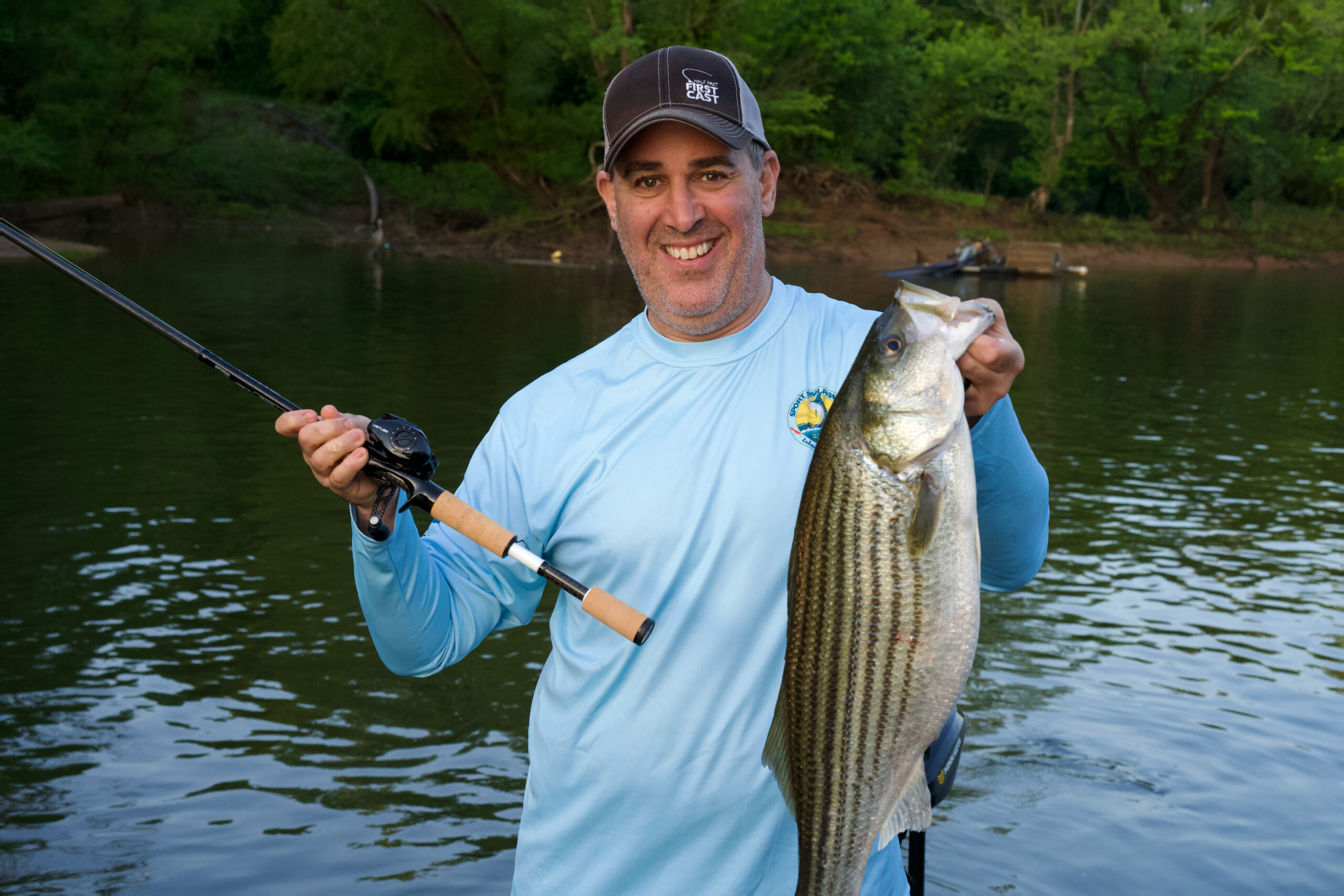
Final Thoughts on the Best Baitcasting Rods for Bass
I’ll admit it: I’m a rod snob. I don’t necessarily judge by price, because I’ve fished $49 rods that have performed admirably and $500 rods that lacked a little something, but I do care deeply about quality components and proper actions. What works well for me may not excel for you. For example, I often like a 7 foot 9 inch to 8 foot rod for heavy-duty flipping and giant offshore crankbaits, but I know those lengths may be unwieldy. It also depends heavily on line choice—the rod you use to flip with fluorocarbon may be far too stiff to flip with braid without pushing the fish’s mouth open on the hook set. Find a series of rods – from one manufacturer or from a series of them—that you like and stock up while you can.
- Best Premium, All-Around: Shimano Poison Adrena PAD170MHB
- Best for Throwing Light Lures: Fenwick World Class WLDB68M-MFC
- Best for Building a Tournament Arsenal: St. Croix Mojo Bass Trigon JOC71MHF
- Best for Jigs: Dobyns Champion XP DC744C FH
- Best for Jerkbaits: G. Loomis IXM-Pro 812C JBR
- Best Bargain: H2OX Mettle 7 foot MH
- Best Budget Rod for Big Baits: Shimano SLX SLXC75HA
- Best Budget: Dobyns Colt CL734C
- Best for Worms and Jigs: Falcon Lowrider LFC 7-MH
- Best to Put a Beating On: Abu-Garcia Veritas PLX VTCRCW70-6
- Best for Offshore Cranking: Lew’s KVD Composite Cranking Cast Rod 7’4″ Heavy
- Best for Flipping and Punching: St. Croix Legend X 7’11” Heavy Casting Rod
